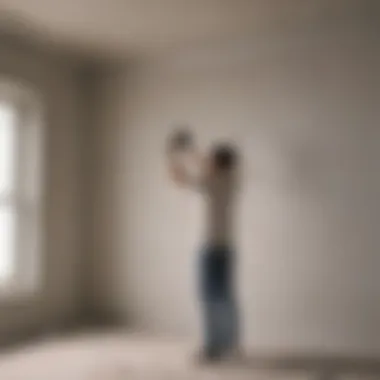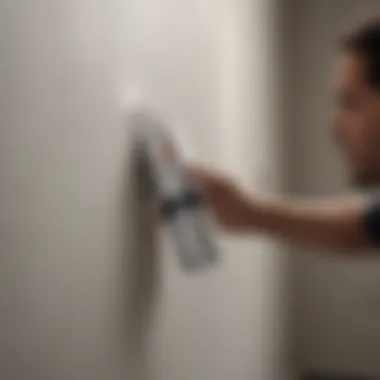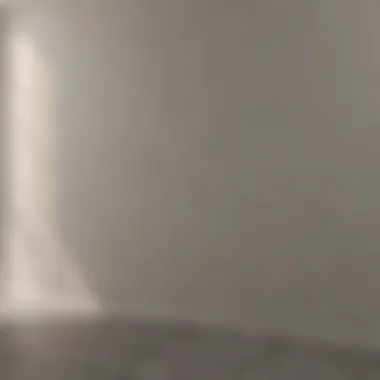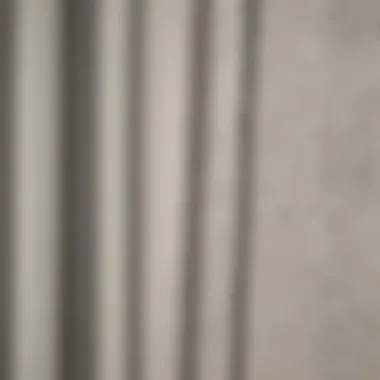Optimal Coats of Kilz Primer for New Drywall: A Comprehensive Guide


Overview of Topic
In this detailed article, we will delve into the intricacies of applying Kilz primer on new drywall surfaces. The process of preparing new drywall for painting is crucial in the home improvement industry as it sets the foundation for a flawless finish. Primer serves as a preparatory coat that ensures better adhesion and uniformity of the final paint layers. Without proper priming, new drywall can absorb paint unevenly, leading to patchy results and necessitating additional coats.
Common Challenges and Solutions
Homeowners often encounter challenges when dealing with new drywall surfaces. One common issue is achieving consistent paint absorption across the wall due to the porous nature of drywall. To overcome this, it is essential to apply the appropriate number of primer coats. Additionally, sealing drywall joints and imperfections with a high-quality primer like Kilz can help create a smooth and uniform surface for painting.
Product Recommendations
When it comes to priming new drywall, selecting the right products can significantly impact the final outcome. Kilz, a renowned brand in the industry, offers a range of primers tailored for different surfaces and requirements. Their products are known for excellent coverage, adhesion, and stain-blocking properties, making them ideal for new drywall applications. Kilz primer also dries quickly, enabling efficient completion of painting projects.
Step-by-Step Guides
To achieve impeccable results when priming new drywall with Kilz, follow these step-by-step instructions:
- Surface Preparation: Before priming, ensure the new drywall surface is clean, dust-free, and dry. Remove any dust or debris with a damp cloth and allow the surface to air dry completely.
- Primer Selection: Choose the appropriate Kilz primer based on the type of drywall and the desired finish. Opt for a high-hide primer to cover imperfections effectively.
- Application Technique: Use a high-quality brush or roller to apply the Kilz primer evenly on the drywall surface. Start from the top and work your way down to ensure uniform coverage.
- Number of Coats: For new drywall, it is recommended to apply at least two coats of Kilz primer. The first coat acts as a sealer and the second enhances the adhesion of the final paint layers.
- Drying Time: Allow each coat of primer to dry completely as per the manufacturer's instructions before applying subsequent coats or painting over the primed surface.
- Final Inspection: Once the final coat of Kilz primer has dried, inspect the surface for any missed spots or imperfections. Touch up as necessary before proceeding with painting.
By following these meticulous steps and choosing high-quality products like Kilz primer, homeowners can achieve a professional and long-lasting finish on new drywall surfaces.
Introduction
In this informative piece, we embark on a journey to unravel the critical aspects of applying Kilz primer on freshly installed drywall surfaces. From the inception of understanding the pivotal role of primer on drywall to the intricate details of utilizing Kilz primer for optimal outcomes, we delve into the essential question of determining the precise number of coats required for pristine new drywall finishes.


Significance of Primer on Drywall
Why Is Primer Necessary on Drywall?
Primer stands as a fundamental component in the realm of drywall preparation, serving as the cornerstone for achieving a flawless paint application. The essence of why primer is indispensable on drywall lies in its exceptional ability to seal the porous surface of the drywall, preventing excessive absorption of paint and ensuring even color distribution. This key characteristic not only facilitates a smooth and uniform paint finish but also enhances the durability of the painted surface, rendering it less prone to peeling or cracking over time. Despite its simplicity, primer's role in creating a stable painting foundation cannot be overstated, making it a popular and wise choice for meticulous homeowners seeking long-lasting and professional results.
Benefits of Using Primer on Drywall
The benefits of utilizing primer on drywall extend far beyond surface preparation. Incorporating primer into the painting process not only enhances paint adhesion and coverage but also helps in concealing imperfections such as blemishes, patches, or joint compound variations on the drywall surface. This advantageous feature not only saves time and effort in subsequent paint applications but also promotes a more aesthetically pleasing end result. Additionally, the use of primer can significantly reduce the number of paint coats required to achieve full coverage, thus making it a cost-effective and time-saving investment for both amateur DIY enthusiasts and seasoned professionals.
About Kilz Primer
Overview of Kilz Primer
A closer look at Kilz primer reveals a premium quality product distinguished by its exceptional adhesion properties and stain-blocking capabilities. Designed to effectively prime surfaces for painting, Kilz primer boasts a quick-drying formula that creates a strong bond with various substrates, including new drywall. Its key characteristic lies in its ability to seal porous surfaces, ensuring an even and consistent paint application. The seamless application of Kilz primer not only enhances the final paint finish but also provides added protection to the underlying surface, making it an indispensable choice for discerning individuals aiming for professional-quality results.
Types of Kilz Primer Available
When it comes to Kilz primer, the market offers a diverse array of options tailored to different painting projects and surface requirements. From the original Kilz Original formula to specialized products like Kilz 2 Latex or Kilz Max, each variant caters to specific needs and preferences. The key characteristic of these different types of Kilz primer lies in their unique formulations, which address various issues such as odors, moisture, or specific staining problems. Whether embarking on a high-humidity area project or tackling a heavily stained surface, there exists a suitable Kilz primer variant to meet the distinct demands of every project, making it a versatile and practical choice for a wide range of painting applications.
Application of Kilz Primer
In this significant part of the article, we delve into the essential aspects surrounding the Application of Kilz Primer on new drywall. Understanding the importance of properly applying primer sets the foundation for achieving impeccable results on your drywall. The specifics and intricacies of using Kilz primer play a crucial role in ensuring a flawless finish. It is vital to consider various elements such as surface preparation, coat number, and application techniques in this process.


Preparing Drywall for Primer
Cleaning the Surface
Cleaning the surface before applying Kilz primer is a crucial step in the process. By ensuring that the surface is free from dust, dirt, and any contaminants, you create a smooth canvas for the primer to adhere to effectively. This meticulous attention to detail is essential in guaranteeing a flawless finish on your new drywall. Cleaning the surface also helps in enhancing the durability and longevity of the primer, ensuring that it performs optimally over time.
Sanding Imperfections
Sanding imperfections on the drywall surface is another essential preparatory step before applying Kilz primer. This process involves smoothing out any bumps, ridges, or rough patches on the surface, ensuring a uniform and level base for the primer. The key characteristic of sanding imperfections lies in its ability to create a seamless foundation for the primer, ultimately leading to a professional-looking finish. Despite the time-consuming nature of this task, the benefits of a well-sanded surface far outweigh the effort, resulting in a superior end result.
Number of Coats
Determining Factors for Coat Number
The number of coats of Kilz primer required for new drywall depends on various determining factors such as the porosity of the surface, the type of drywall, and the desired finish. Understanding these factors is crucial in determining the optimal number of coats needed to achieve a flawless result. By evaluating the specific characteristics of the surface and considering environmental conditions, you can make an informed decision regarding the coat number, ensuring the primer's effectiveness.
Ideal Number of Coats for New Drywall
Determining the ideal number of coats for new drywall is a critical aspect of achieving a professional finish. While some surfaces may require multiple coats for full coverage and adhesion, others may only need a single coat for optimal results. The ideal number of coats ensures adequate protection, coverage, and longevity for your new drywall surface, safeguarding it against potential damage and enhancing its overall aesthetic appeal.
Applying Kilz Primer
Techniques for Application


Mastering the techniques for applying Kilz primer is essential for a successful outcome. Whether you opt for brush application, roller application, or spray application, each technique comes with its unique advantages and considerations. The key characteristic of applying Kilz primer lies in achieving consistent coverage and uniformity across the surface, ensuring a professional-looking finish. By selecting the appropriate technique based on your specific requirements, you can enhance the overall quality and durability of the primer application.
Drying and Recoating Time
Understanding the drying and recoating time of Kilz primer is crucial in ensuring an efficient and effective application process. Allowing sufficient time for the primer to dry between coats is essential to prevent uneven coverage and promote proper adhesion. The key characteristic of the drying and recoating time lies in facilitating optimal bonding and curing of the primer, ultimately enhancing its durability and performance. By adhering to the recommended time intervals for drying and recoating, you can achieve a smooth and flawless finish on your new drywall surface.
Finishing Touches
When it comes to completing a new drywall project, the final touches play a significant role in achieving a flawless finish that not only looks great but also holds up well over time. The term 'finishing touches' encompasses the last steps taken after the primer has been applied and dried. These steps often involve sanding between coats and conducting final inspections to ensure the surface is ready for painting or any additional treatments. Emphasizing the importance of these finishing touches not only improves the aesthetic appeal of the drywall but also enhances its longevity and durability. Housewives and homeowners aiming for a professional-level finish should prioritize these aspects to enjoy a seamless end result.
Sanding Between Coats
Importance of Sanding
Sanding between coats of primer is a critical step in the drywall preparation process. It involves using sandpaper to smooth out any imperfections or rough spots on the surface before applying subsequent coats of primer or paint. This meticulous process helps create a uniform and level surface, ensuring the primer adheres properly and that the final finish appears smooth and flawless. The gentle abrasion caused by sanding promotes adhesion and reduces the visibility of joints and blemishes, resulting in a professional-looking outcome. Housewives and house owners should consider sanding between coats as a necessary step towards achieving a polished and refined drywall surface.
Recommended Grit for Sanding
Choosing the right grit of sandpaper is crucial when sanding between coats of primer on new drywall. The grit refers to the coarseness or fineness of the sandpaper, with lower numbers indicating a rougher texture and higher numbers representing a finer texture. For drywall prep, it is recommended to start with a medium-grit sandpaper (around 120 to 150 grit) to smooth out initial imperfections without damaging the surface. Subsequent coats may require a finer grit (200 to 400) for a smoother finish. Using the appropriate grit ensures an effective sanding process that helps achieve an even texture and optimal primer adhesion. Understanding the recommended grit for sanding allows housewives and homeowners to execute this step with precision, resulting in a perfectly prepped surface ready for the next painting stage.
Final Inspections
Checking for Smoothness
Conducting a thorough check for smoothness is a crucial aspect of the final inspection phase when priming new drywall. This step involves running your hands or a light source along the surface to detect any remaining imperfections, bumps, or rough areas that may have been missed during the sanding process. Ensuring the surface feels uniformly smooth to the touch is essential for a seamless paint application and desired finish. Housewives and house owners keen on achieving a professional outcome should dedicate time to checking for smoothness before proceeding to the painting stage.
Addressing Any Imperfections
Addressing any imperfections discovered during the final inspection is vital for achieving a flawless end result on new drywall surfaces. Whether it's minor dents, scratches, or uneven areas, taking the time to correct these imperfections before painting can make a significant difference in the overall appearance of the wall. Depending on the severity of the imperfections, solutions may involve additional sanding, filling with spackling compound, or re-priming specific areas. By addressing these issues proactively, housewives and homeowners can ensure a pristine and professional-looking finish that enhances the aesthetic appeal of their living spaces.







